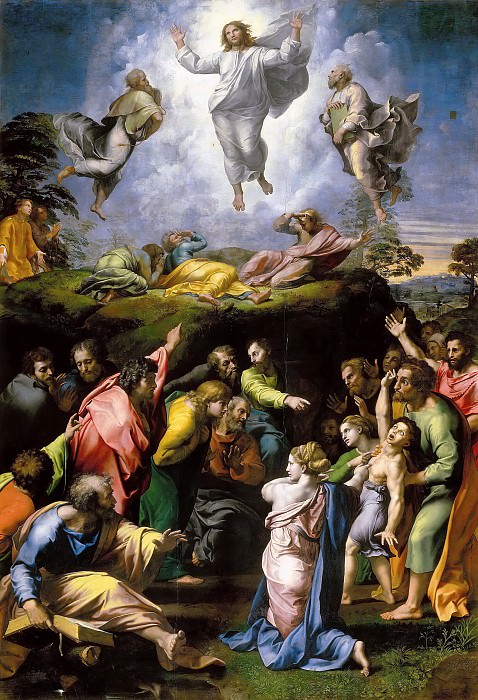Transfiguration of Christ Raphael (1483-1520)
Raphael – Transfiguration of Christ
Edit attribution
Download full size: 2332×3419 px (2,5 Mb)
Painter: Raphael
Location: Vatican Museums (Musei Vaticani), Vatican.
Raphael Santi was a famous Renaissance artist who painted in his short 37 years, many world famous paintings. Raphael’s greatest fame came from his painting of the Transfiguration of the Lord, or the Transfiguration of Christ in another interpretation. The huge canvas was commissioned for the Catholic cathedral in Narbonne, Cardinal Giulio de’ Medici himself in 1517. The artist began work on the painting and at the same time painted a canvas personally for the cardinal.
Description of Raphael Santi’s painting The Transfiguration of the Lord
Raphael Santi was a famous Renaissance artist who painted in his short 37 years, many world famous paintings. Raphael’s greatest fame came from his painting of the Transfiguration of the Lord, or the Transfiguration of Christ in another interpretation. The huge canvas was commissioned for the Catholic cathedral in Narbonne, Cardinal Giulio de’ Medici himself in 1517.
The artist began work on the painting and at the same time painted a canvas personally for the cardinal. For his picture the artist used a well-known biblical story described in the Gospels, which tells that Christ decided to show his disciples his true identity. As the scripture says, Jesus took the three apostles Peter, James and Jakeem and led them up a high mountain where he transfigured himself in front of them, appearing in a luminous image surrounded by a divine halo. Then the voice of God sounded, confirming to the apostles that Jesus was his true and only son.
Coming down the mountain, the apostles and Jesus meet a crowd of people who accompany the father and his son, who is possessed by the devil, to ask Christ for his cure.
And here begins the plot of Raphael’s painting recounting this moment.
In the foreground are the apostles, reclining in various poses as they await the descent of Christ. Jesus himself is hovering in a circle of light above the rest of the people, he is weightless and beautiful. The people stretch out their hands to him, and the old man and the boy stand still waiting to be healed. The artist has also depicted a kneeling woman who is waiting with everyone else for a miracle. All these people are pointing to Christ, their faces full of trembling excitement. He comes and heals the child, driving away the evil spirit.
The upper part of the painting is illuminated by the divine light emanating from Christ, while the lower part is darkened.
The top part was reportedly painted by the artist himself, while the lower part was completed by his pupils, as Rafael Santi tragically died in 1520. But his immortal canvas can be considered a model for contemporary artists to emulate.
Кому понравилось
Пожалуйста, подождите
На эту операцию может потребоваться несколько секунд.
Информация появится в новом окне,
если открытие новых окон не запрещено в настройках вашего браузера.
You need to login
Для работы с коллекциями – пожалуйста, войдите в аккаунт (open in new window).














COMMENTS: 3 Ответы
класс!
Очень правдиво, шедевр!
Присоединяйтесь к Charverse AI сейчас, чтобы улучшить свои #SocialSkills и испытать #AICompanionship.
You cannot comment Why?
This is Raphaels Transfiguration of Christ, a masterful High Renaissance oil painting. The artwork is split into two distinct compositional parts.
In the upper section, Christ is depicted in a radiant, white garment, glowing with divine light as he ascends into heaven. His arms are outstretched in a gesture of blessing or surrender. Flanking him are the prophets Elijah and Moses, who are also depicted in the air. Below them, on a grassy knoll, lie three of Jesuss disciples – Peter, James, and John – in various states of awe and prostration, shielding their eyes from the blinding light.
The lower section of the painting depicts a chaotic scene of turmoil and human desperation. A group of apostles and other figures are gathered at the base of the hill, reacting to the story of a possessed boy. They are pleading with the apostles for help, highlighting their earthly struggles and the need for divine intervention. The gestures and expressions here are dynamic and forceful, portraying suffering, concern, and a desperate plea for healing.
Subtexts:
The painting masterfully juxtaposes the divine and the human, the spiritual and the earthly. The Transfiguration itself is a pivotal moment in the Gospels, where Jesuss divine nature is revealed to his closest disciples. This heavenly vision of Christs glory serves as a prefiguration of his resurrection and ascension, offering a glimpse of salvation and divine power.
The lower scene, depicting the possessed boy and the struggling apostles, represents the earthly realm and its afflictions. It underscores the ongoing need for Christs presence and intervention in the face of human suffering and spiritual darkness. The contrast between the serene, divine manifestation above and the turmoil below emphasizes the dual nature of Christ – both divine and human – and the challenges faced by his followers in bridging these two realms. The painting, therefore, serves as a powerful affirmation of Christs divinity and a testament to the redemptive power of faith in overcoming earthly tribulations.